slabbe-0.1.spkg released
27 août 2014 | Catégories: sage, slabbe spkg | View CommentsThese is a summary of the functionalities present in slabbe-0.1 optional Sage package. It depends on version 6.3 of Sage because it uses RecursivelyEnumeratedSet code that was merged in 6.3. It contains modules on digital geometry, combinatorics on words and more.
Install the optional spkg (depends on sage-6.3):
sage -i http://www.liafa.univ-paris-diderot.fr/~labbe/Sage/slabbe-0.1.spkg
In each of the example below, you first have to import the module once and for all:
sage: from slabbe import *
To construct the image below, make sure to use tikz package so that view is able to compile tikz code when called:
sage: latex.add_to_preamble("\\usepackage{tikz}")
sage: latex.extra_preamble()
'\\usepackage{tikz}'
Draw the part of a discrete plane
sage: p = DiscretePlane([1,pi,7], 1+pi+7, mu=0) sage: d = DiscreteTube([-5,5],[-5,5]) sage: I = p & d sage: I Intersection of the following objects: Set of points x in ZZ^3 satisfying: 0 <= (1, pi, 7) . x + 0 < pi + 8 DiscreteTube: Preimage of [-5, 5] x [-5, 5] by a 2 by 3 matrix sage: clip = d.clip() sage: tikz = I.tikz(clip=clip) sage: view(tikz, tightpage=True)
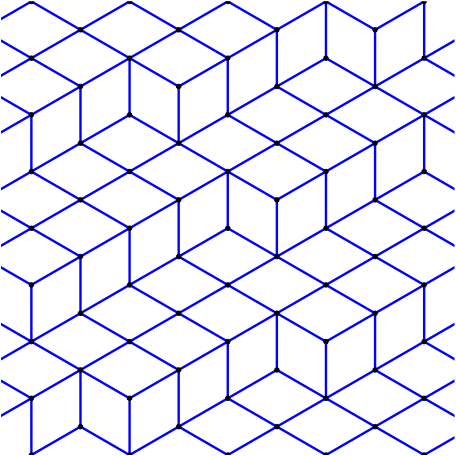
Draw the part of a discrete line
sage: L = DiscreteLine([-2,3], 5) sage: b = DiscreteBox([0,10], [0,10]) sage: I = L & b sage: I Intersection of the following objects: Set of points x in ZZ^2 satisfying: 0 <= (-2, 3) . x + 0 < 5 [0, 10] x [0, 10] sage: I.plot()
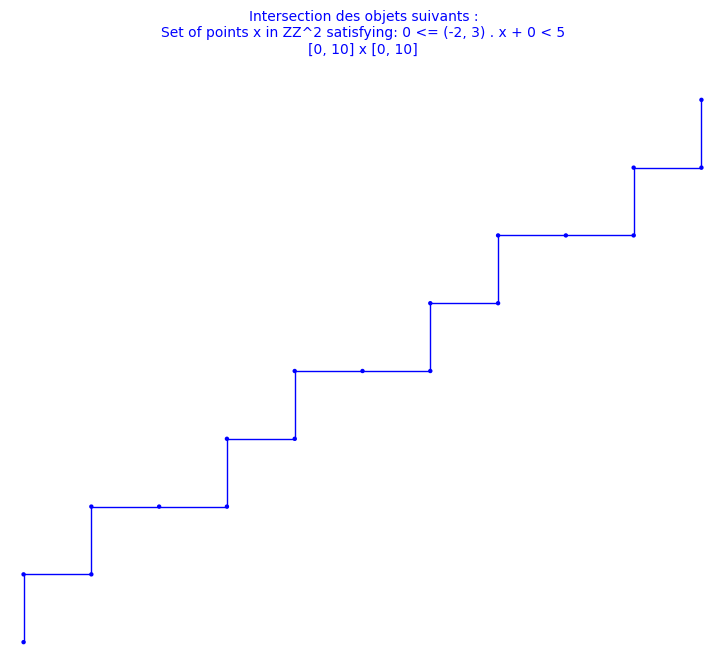
Double square tiles
This module was developped for the article on the combinatorial properties of double square tiles written with Ariane Garon and Alexandre Blondin Massé [BGL2012]. The original version of the code was written with Alexandre.
sage: D = DoubleSquare((34,21,34,21)) sage: D Double Square Tile w0 = 3032321232303010303230301012101030 w4 = 1210103010121232121012123230323212 w1 = 323030103032321232303 w5 = 101212321210103010121 w2 = 2321210121232303232123230301030323 w6 = 0103032303010121010301012123212101 w3 = 212323032321210121232 w7 = 030101210103032303010 (|w0|, |w1|, |w2|, |w3|) = (34, 21, 34, 21) (d0, d1, d2, d3) = (42, 68, 42, 68) (n0, n1, n2, n3) = (0, 0, 0, 0) sage: D.plot()
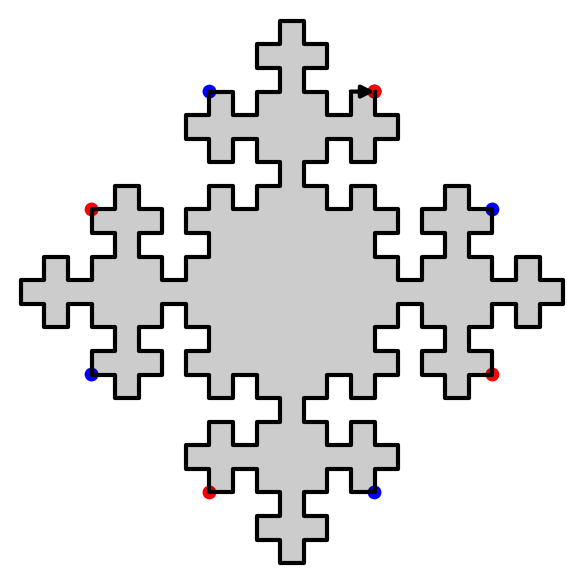
sage: D.extend(0).extend(1).plot()
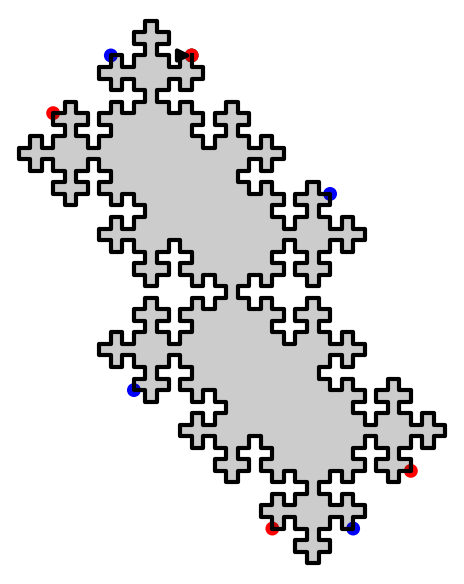
We have shown that using two invertible operations (called SWAP and TRIM), every double square tiles can be reduced to the unit square:
sage: D.plot_reduction()
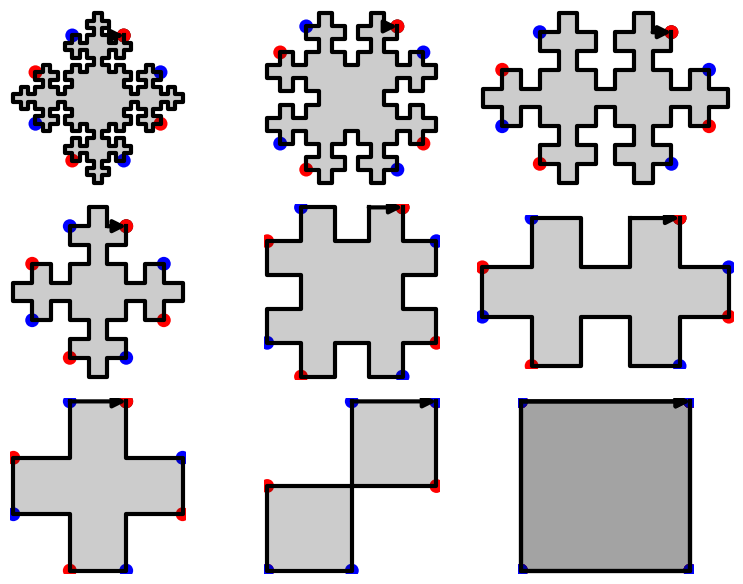
The reduction operations are:
sage: D.reduction() ['SWAP_1', 'TRIM_1', 'TRIM_3', 'SWAP_1', 'TRIM_1', 'TRIM_3', 'TRIM_0', 'TRIM_2']
The result of the reduction is the unit square:
sage: unit_square = D.apply(D.reduction()) sage: unit_square Double Square Tile w0 = w4 = w1 = 3 w5 = 1 w2 = w6 = w3 = 2 w7 = 0 (|w0|, |w1|, |w2|, |w3|) = (0, 1, 0, 1) (d0, d1, d2, d3) = (2, 0, 2, 0) (n0, n1, n2, n3) = (0, NaN, 0, NaN) sage: unit_square.plot()
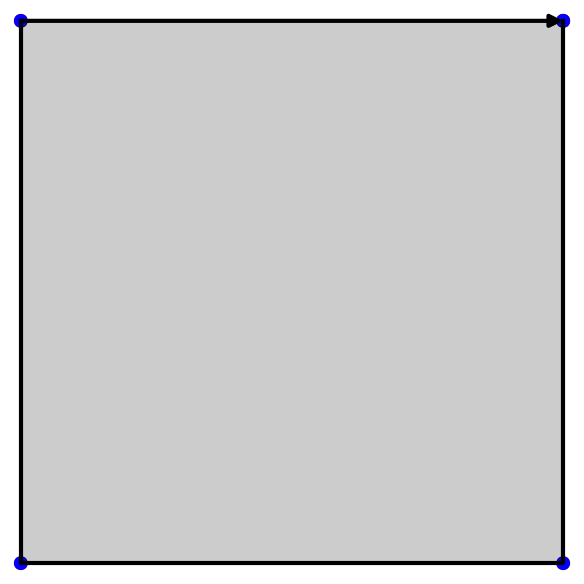
Since SWAP and TRIM are invertible operations, we can recover every double square from the unit square:
sage: E = unit_square.extend(2).extend(0).extend(3).extend(1).swap(1).extend(3).extend(1).swap(1) sage: D == E True
Christoffel graphs
This module was developped for the article on a d-dimensional extension of Christoffel Words written with Christophe Reutenauer [LR2014].
sage: G = ChristoffelGraph((6,10,15)) sage: G Christoffel set of edges for normal vector v=(6, 10, 15) sage: tikz = G.tikz_kernel() sage: view(tikz, tightpage=True)
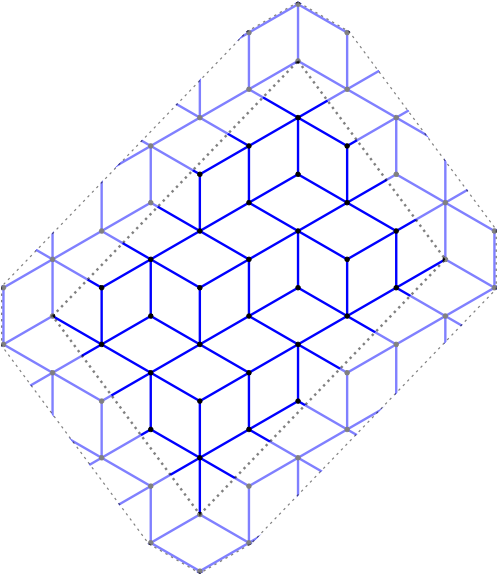
Bispecial extension types
This module was developped for the article on the factor complexity of infinite sequences genereated by substitutions written with Valérie Berthé [BL2014].
The extension type of an ordinary bispecial factor:
sage: L = [(1,3), (2,3), (3,1), (3,2), (3,3)] sage: E = ExtensionType1to1(L, alphabet=(1,2,3)) sage: E E(w) 1 2 3 1 X 2 X 3 X X X m(w)=0, ordinary sage: E.is_ordinaire() True
Creation of a strong-weak pair of bispecial words from a neutral not ordinaire word:
sage: p23 = WordMorphism({1:[1,2,3],2:[2,3],3:[3]})
sage: e = ExtensionType1to1([(1,2),(2,3),(3,1),(3,2),(3,3)], [1,2,3])
sage: e
E(w) 1 2 3
1 X
2 X
3 X X X
m(w)=0, not ord.
sage: A,B = e.apply(p23)
sage: A
E(3w) 1 2 3
1
2 X X
3 X X X
m(w)=1, not ord.
sage: B
E(23w) 1 2 3
1 X
2
3 X
m(w)=-1, not ord.
Fast Kolakoski word
This module was written for fun. It uses cython implementation inspired from the 10 lines of C code written by Dominique Bernardi and shared during Sage Days 28 in Orsay, France, in January 2011.
sage: K = KolakoskiWord() sage: K word: 1221121221221121122121121221121121221221... sage: %time K[10^5] CPU times: user 1.56 ms, sys: 7 µs, total: 1.57 ms Wall time: 1.57 ms 1 sage: %time K[10^6] CPU times: user 15.8 ms, sys: 30 µs, total: 15.8 ms Wall time: 15.9 ms 2 sage: %time K[10^8] CPU times: user 1.58 s, sys: 2.28 ms, total: 1.58 s Wall time: 1.59 s 1 sage: %time K[10^9] CPU times: user 15.8 s, sys: 12.4 ms, total: 15.9 s Wall time: 15.9 s 1
This is much faster than the Python implementation available in Sage:
sage: K = words.KolakoskiWord() sage: %time K[10^5] CPU times: user 779 ms, sys: 25.9 ms, total: 805 ms Wall time: 802 ms 1
References
| [BGL2012] | A. Blondin Massé, A. Garon, S. Labbé, Combinatorial properties of double square tiles, Theoretical Computer Science 502 (2013) 98-117. doi:10.1016/j.tcs.2012.10.040 |
| [LR2014] | Labbé, Sébastien, and Christophe Reutenauer. A d-dimensional Extension of Christoffel Words. arXiv:1404.4021 (April 15, 2014). |
| [BL2014] | V. Berthé, S. Labbé, Factor Complexity of S-adic sequences generated by the Arnoux-Rauzy-Poincaré Algorithm. arXiv:1404.4189 (April, 2014). |
Releasing slabbe, my own Sage package
27 août 2014 | Catégories: sage, slabbe spkg | View CommentsSince two years I wrote thousands of line of private code for my own research. Each module having between 500 and 2000 lines of code. The code which is the more clean corresponds to code written in conjunction with research articles. People who know me know that I systematically put docstrings and doctests in my code to facilitate reuse of the code by myself, but also in the idea of sharing it and eventually making it public.
I did not made that code into Sage because it was not mature enough. Also, when I tried to make a complete module go into Sage (see #13069 and #13346), then the monstrous never evolving #12224 became a dependency of the first and the second was unofficially reviewed asking me to split it into smaller chunks to make the review process easier. I never did it because I spent already too much time on it (making a module 100% doctested takes time). Also, the module was corresponding to a published article and I wanted to leave it just like that.
Getting new modules into Sage is hard
In general, the introduction of a complete new module into Sage is hard especially for beginners. Here are two examples I feel responsible for: #10519 is 4 years old and counting, the author has a new work and responsabilities; in #12996, the author was decouraged by the amount of work given by the reviewers. There is a lot of things a beginner has to consider to obtain a positive review. And even for a more advanced developper, other difficulties arise. Indeed, a module introduces a lot of new functions and it may also introduce a lot of new bugs... and Sage developpers are sometimes reluctant to give it a positive review. And if it finally gets a positive review, it is not available easily to normal users of Sage until the next release of Sage.
Releasing my own Sage package
Still I felt the need around me to make my code public. But how? There are people (a few of course but I know there are) who are interested in reproducing computations and images done in my articles. This is why I came to the idea of releasing my own Sage package containing my public research code. This way both developpers and colleagues that are user of Sage but not developpers will be able to install and use my code. This will make people more aware if there is something useful in a module for them. And if one day, somebody tells me: "this should be in Sage", then I will be able to say : "I agree! Do you want to review it?".
Old style Sage package vs New sytle git Sage package
Then I had to chose between the old and the new style for Sage packages. I did not like the new style, because
- I wanted the history of my package to be independant of the history of Sage,
- I wanted it to be as easy to install as sage -i slabbe,
- I wanted it to work on any recent enough version of Sage,
- I wanted to be able to release a new version, give it to a colleague who could install it right away without changing its own Sage (i.e., updating the checksums).
Therefore, I choose the old style. I based my work on other optional Sage packages, namely the SageManifolds spkg and the ore_algebra spkg.
Content of the initial version
The initial version of the slabbe Sage package has modules concerning four topics: Digital geometry, Combinatorics on words, Combinatorics and Python class inheritance.
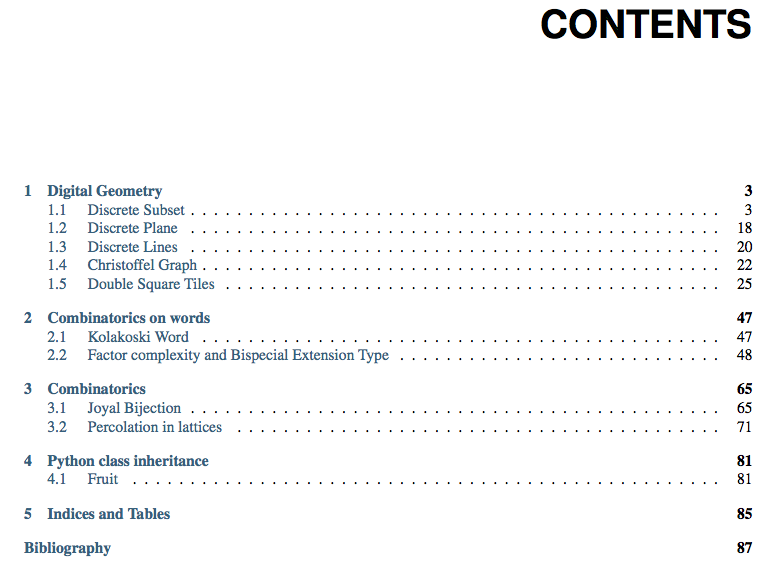
For installation or for release notes of the initial version of the spkg, consult the slabbe spkg section of the Sage page of this website.
« Previous Page
